| The State of Black Student Freshman Enrollments at the Nation’s Highest-Ranked Colleges and Universities For the sixteenth consecutive year, JBHE publishes its survey of the percentages of black first-year students at the nation’s highest-ranked universities and liberal arts colleges. For the second year in a row, Columbia University leads the universities in the statistical ranking for enrolling the highest percentage of black students in first-year classes. This year, Amherst College has the highest percentage of black students in its entering class of the nation’s highest-ranked liberal arts institutions. Once more, this year The Journal of Blacks in Higher Education has completed its survey of admissions offices at the nation’s highest-ranked research universities. Again, we calculate and compare the percentages of African-American students in this fall’s entering freshman classes. As before, our survey also includes racial data on first-year classes at the nation’s leading liberal arts colleges. As in the past, our surveys publish information on the total number of African-American applicants at the various institutions, their acceptance rates, enrollment numbers, and yield rates (the percentage of students who eventually enroll in the colleges at which they were accepted). Here are the results of this year’s survey.
A year ago Columbia University headed the JBHE rankings for the first time. This year Columbia, once again, has the highest percentage of black freshman students among the 30 highest-ranking universities in the nation. There are 162 black freshmen at Columbia this fall. This number has increased 6 percent from a year ago. Going back to 2004 the percentage of blacks in the freshman class at Columbia has increased from 6.8 percent to 12.1 percent. The number of black freshmen has increased by 80 percent since 2004. JBHE has no explanation for the huge gains at Columbia. President Lee Bollinger has been under fire on many issues. But no one can dispute his national leadership in advancing affirmative action in college admissions. For six of the past nine years the University of North Carolina at Chapel Hill has stood atop our rankings. But in 2007 Chapel Hill dropped to third place. This year Chapel Hill moves up one spot to second position. There are 417 black first-year students at the university this fall. They make up a substantial 10.8 percent of the freshman class. Stanford University showed solid progress this year. There are 180 black freshmen at Stanford this fall. They are 10.5 percent of the entering class. This puts Stanford third in our survey among the 30 highest-ranked universities. Last year, when blacks were 8.3 percent of the entering class, Stanford ranked eleventh in our survey. Until recently Stanford’s position has been uneven. In the years when Condoleezza Rice held the powerful provost position at Stanford (1993-1999), her conservative views probably had a chilling effect on the institution’s commitment to student outreach. Duke University, which has led the JBHE rankings in the past, is fourth in this year’s survey, up from seventh in 2007. There are 172 black freshmen at Duke this year making up 10.1 percent of the entering class. It appears that Duke has completely overcome the reputational damage from the racial controversy surrounding the arrest of three white lacrosse players who were accused of raping a black student from nearby North Carolina Central University. The charges against the students were later dropped. Duke’s strong commitment to racial outreach shows in its recent success in recruiting Harvard’s black scholar J. Lorand Matory to head its African-American studies department. (See page 6 of this issue of JBHE.) This year Yale turned in a strong performance with a freshman class that is 10 percent black. This places Yale in fifth place overall and second to Columbia among the Ivy League universities.
Traditionally, MIT has always been far more successful in attracting highly qualified black students than its West Coast counterpart, the California Institute of Technology. For the second straight year, we have no way of comparing results. Once again, CalTech was the only university among the nation’s 30 highest-ranked institutions that declined to provide data to JBHE. We note that on three occasions over the past 13 years there have been no black students entering the freshman class at CalTech. Often, but not always, a failure to supply data suggests poor performance. In addition to Columbia and Yale, two other members of the Ivy League, the University of Pennsylvania and Dartmouth College, have freshman classes that are more than 9 percent black. They rank seventh and eighth in our survey. The 101 black freshmen at Dartmouth is noteworthy because the college is located in a rural area of New Hampshire far from any black population center. In the first five years of our survey, from 1993 to 1997, the University of Virginia consistently reported the highest percentage of black freshmen of any of the nation’s high-ranking universities. But in subsequent years the university appears to have back-pedaled in its commitment to increasing the racial diversity of its student body. This negative trend appeared to halt in 2005 when blacks were a very substantial 10.5 percent of the entering class. This placed the University of Virginia in second place in our 2005 survey. In 2007 the University of Virginia tied for the top spot with Columbia University. This year the University of Virginia dropped all the way to ninth place in our survey. Blacks make up 8.8 percent of the freshman class, down from 11.4 percent last year. The number of black applicants, the black student acceptance rate, and the black student yield were all down from a year ago. Emory University in Atlanta holds the tenth position in our survey of the nation’s highest-ranked universities. Blacks are 8.8 percent of the entering class at Emory. Emory ranked in fifth position last year when 9.6 percent of its freshmen were black. Harvard University has dropped out of the top 10 in this year’s survey. In fact, in its percentage of black freshmen, Harvard is now in the lower half of the eight Ivy League schools. Princeton, Brown, and Cornell rank lower and are at the bottom of the Ivy League in black freshman enrollments. At Cornell the percentage of blacks in the entering class increased each year from 2003 to 2006. Since 2006 the percentage of blacks in the entering class at Cornell has declined from 5.9 percent to 4.5 percent. This year we report an important positive development. In 2008, for the first time in the history of the JBHE survey, five of the nation’s 30 highest-ranked universities entered a freshman class that is at least 10 percent black. This is the best news we have seen in many years.
The Gainers Compared to Last Year’s Results
For the universities posting progress, none of the gains were as spectacular as those achieved in many of our past surveys. For example, in 2007 six of the 30 highest-ranked universities posted gains in black freshmen of at least 30 percent. This year there are no universities that posted a 30 percent increase. The largest percentage gain this year was at Stanford University. There the number of black freshmen was 25.9 percent higher than a year ago. This year Wake Forest University and Dartmouth College posted gains of more than 17 percent. The University of Chicago and the University of Southern California both showed gains of more than 16 percent. Over the years the University of Chicago has been a laggard in enrolling African-American undergraduate students. This reflected a conservative culture that has controlled admissions policy for many years. But in recent years the progress has been substantial. Currently there are 106 black freshman students at the university. This is precisely double the number of black freshman students at the university from just three years ago in 2005. The University of Pennsylvania, the University of Michigan, Washington University, Duke University, and the University of California at Los Angeles all posted significant one-year gains in the number of black freshmen. All showed increases of at least 10 percent. Good progress at the University of Michigan was unexpected. In November 2006, voters in Michigan overwhelmingly approved Proposal 2, which was called by the misleading title, The Michigan Civil Rights Initiative. This initiative prohibited the University of Michigan and other state universities from considering race as a positive factor in their admissions decisions. But aware that the initiative stood a good chance of voter approval, admissions officials at the University of Michigan processed large numbers of applications for last year’s fall 2007 entering class before the law took effect. Even so, the percentage of blacks in last year’s entering class declined from 6.1 percent in 2006 to 5.6 percent in 2007. Students entering the University of Michigan in the fall of 2008 were in the first class completely covered by the ban on race-sensitive admissions. Yet there are 40 more black freshmen at the University of Michigan this fall than a year ago. The black percentage of the freshman class increased from 5.6 percent to 6.5 percent. University president Mary Sue Coleman attributes the university’s success to greater emphasis on outreach to black and minority students. “We have worked extremely hard to build a diverse class that reflects the world around us,” Coleman said. But she warns, “We cannot become complacent in our diversity efforts. There is still much work to do.” The steady increase in black freshmen at UCLA is good news building on the spectacular gain last year. Two years ago, in 2006, there were 99 black first-year students at UCLA. They then made up only 2 percent of all freshman students at UCLA. In fact, the black presence in the entering class at UCLA was lower in 2006 than at any time since the 1960s. In an effort to increase diversity in the student body, in 2007 the UCLA administration adopted a new admissions model that followed a “holistic” approach which considers academic merit in the context of a student’s position in society. Under the new plan, a student of any race who comes from a low-income family and attends high school in an inner-city school district that has a poor record in sending kids on to college may be viewed in a more favorable light by admissions officials than a student with slightly higher academic credentials who was raised in an upper-middle-class family and attended high school in a wealthy suburban district. This is essentially class-based affirmative action. This new admissions formula was highly successful in increasing black enrollments. Last year UCLA more than doubled its number of black freshman students. There were 213 blacks in the 2007 entering class. This year the progress continued. There are 235 black freshmen at UCLA this year, up by slightly more than 10 percent. Blacks are 4.8 percent of the freshman class at UCLA. However, we note that this progress still places UCLA near the bottom of the JBHE rankings.
Universities Showing a One-Year Decline in Black Freshmen Thirteen high-ranking universities showed one-year declines in black freshmen compared to 2007. Seven high-ranking universities posted one-year declines in black freshmen of greater than 10 percent. Last year there were only four. At Northwestern University in Evanston, Illinois, there are 92 black freshmen, down 17 percent from a year ago. Blacks make up only 4.5 percent of the entering class. The low number of incoming black students at Northwestern has already sparked protests on campus this fall. An outdoor student rally was held in October protesting the university’s lack of commitment to racial diversity. A generation ago, Northwestern’s performance was good. Blacks made up nearly 10 percent of the total undergraduate enrollment at Northwestern in 1976. Now black enrollments are under 6 percent. And our new data on black freshman enrollments show that the black percentage of total enrollments will go down. One year ago, in 2007, Tufts University in Medford, Massachusetts, posted large gains in black first-year enrollments. There were 97 black freshmen at Tufts in 2007, an increase of 83 percent from the previous year. This year the number of black freshmen is down nearly 24 percent. Blacks are 5.7 percent of the entering class compared to 7.1 percent a year ago. This year, the University of Notre Dame had a significant drop in black freshmen of 33.7 percent. Last year, in 2007, there were 92 black first-year students at Notre Dame. They made up 4.6 percent of the first-year class. But now in 2008 there are 61 black freshmen at Notre Dame comprising just 3 percent of the incoming class. This was the lowest percentage of the 29 high-ranking universities that responded to the JBHE survey. The largest percentage decline in black students was at Vanderbilt University. Back in 2006 there were 172 black freshmen at Vanderbilt. They then made up 10.3 percent of the first-year class. This put Vanderbilt fourth overall in our survey last year. In fact, Vanderbilt has had a solid record over the past decade in increasing black enrollments at both the undergraduate and graduate level. Vanderbilt has also made dramatic gains in numbers of black faculty. But this year the number of black freshmen at Vanderbilt plummeted from 172 to 105, a huge drop of 39 percent. Blacks are 6.7 percent of this year’s entering class. Vanderbilt falls from fourth place in last year’s survey all the way down to a tie for eighteenth position among the 30 high-ranking universities. Roberta Bell, director of institutional research at Vanderbilt, told JBHE that the overall freshman class size was reduced this year. She also notes that there was a sharp drop in black student yield from 47.4 percent to 32.6 percent. She attributed this to the fact that Vanderbilt is now attracting applicants with far superior academic qualifications than in years past. These applicants are also being accepted at Ivy League colleges and other high-ranking universities. She explains that Vanderbilt has lost many of these high-scoring black students to other high-ranking educational institutions. Dr. Bell also notes a sharp 60 percent rise in the number of students who did not report their race.
Institutional Acceptance Rates by Race: It is well recognized that the percentage of black applicants who actually receive invitations to join the freshman class is a valuable gauge of an institution’s commitment to racial diversity. Yet this figure is regarded as the most sensitive of all admissions data. This is particularly true for some of the very highest ranked institutions. Of the 29 highest-ranked universities that responded to our survey, eight declined to reveal their black acceptance rates. Unquestionably, public and private threats to affirmative action policies in college admissions have been a factor in producing this sensitivity. With this in mind, admissions officers — who on the whole are solidly supportive of affirmative action — have apprehensions when statistics on black admissions are made available to the public. There are standard concerns too that racial conservatives on faculties and among alumni and trustees may interpret the figures as suggesting a so-called “dumbing down” of academic standards and a favoring of “unqualified” blacks over perhaps more qualified whites. But, at the same time, it is critical to keep in mind that an institution’s high black acceptance rate often indicates nothing more than the fact that the admissions office of a given institution has a very strong and well-qualified black applicant pool. At 14 of the 21 universities that supplied acceptance rate data to JBHE, the black student acceptance rate was higher than the acceptance rate for all students. In some cases the differences were substantial. For instance, at MIT the black student acceptance rate of 27 percent was more than twice as high as the 11.9 percent acceptance rate for all applicants. At Brown University 22 percent of black students were accepted compared to 13.7 percent of all applicants. At the University of Chicago 48.7 percent of blacks were accepted whereas 27.9 percent of all applicants received notices of acceptance. Surprisingly, seven of the high-ranking universities we surveyed had black acceptance rates that were in fact lower than the overall acceptance rate. At the University of California at Berkeley and the University of California at Los Angeles, both of which were prohibited from taking race into account during the 2008 admissions process, the black acceptance rate was significantly below the rate for all accepted students. The black acceptance rate was also lower than the overall rate at Emory University, the University of Southern California, the University of North Carolina, Washington University, and Wake Forest University.
Black Student Yield: Harvard Regains the Top Spot So-called yield, the percentage of applicants who decide to go to a college that issues an invitation to them, has become the standard measure of an institution’s strength and drawing power. For most of the past 20 years Harvard University has been the nation’s gold standard in student yield percentage for both black and white students. But in both 2002 and 2003 this top performance in student yield moved to Stanford University. In 2003 the black student yield at Stanford was 67.9 percent, the highest in the country. In 2005 and 2006 Harvard University once again posted the highest black student yield. A year ago, in 2007, MIT ranked first in black student yield. Last year MIT posted a black student yield of 65.1 percent, slightly higher than the 64.5 percent black student yield at Harvard. This year Harvard posted the highest black student yield at 64.1 percent. MIT came in a close second with a black student yield of 63.9 percent. Stanford University ranked third this year with a black student yield of 60.4 percent. This improved from 54 percent a year ago. The University of Pennsylvania and UCLA also posted black student yields above 50 percent in 2008. In 2008 the lowest black student yield of 19.4 percent was reported at Carnegie Mellon University. Emory University has the second-lowest figure at 21.6 percent. This year Johns Hopkins University, Tufts University, and Northwestern University had black student yields below 30 percent. Columbia, Duke, Yale, Dartmouth, and Princeton did not disclose their black student yield. In some cases this may indicate the presence of social or cultural barriers at a particular institution that discourages a black student from accepting an offer of admission. In others it many mean nothing, or simply an institutional policy of not disclosing sensitive data. Or, a particular university may withhold the number of black students who are accepted for admission to prevent revealing to alumni the extent of racial preferences in the admissions process.
Black Freshmen at Liberal Arts Colleges Now we turn to black freshmen at the nation’s highest-ranked liberal arts colleges. For 15 years JBHE has collected black student admissions data on the highest-ranked liberal arts colleges. Over this long period, on five occasions Wesleyan University in Middletown, Connecticut, has enrolled the highest percentage of black first-year students. Also, in this period there have been five years when Amherst College reported the highest percentage of black freshmen.
This year Amherst once again leads the rankings. There are 49 black freshmen at Amherst College this year, making up 11.2 percent of the entering class. Amherst has maintained its top ranking from a year ago despite the fact that the number of black freshmen at the college is slightly lower than was the case in 2007. This year, Williams College in western Massachusetts placed second with a freshman class that is 10.4 percent black. Williams has moved to second place from third position last year. In recent years black enrollments at Swarthmore have been on a roller-coaster ride. In 1998 our records show that there were 43 black freshmen in the entering class at Swarthmore College. That year they made up 11.6 percent of all first-year students. This was the highest percentage JBHE has ever recorded of blacks in an entering class at any of the nation’s 30 highest-ranked liberal arts colleges. Just three years later, in 2001, the number of black freshmen at Swarthmore dropped to 18, a huge decline of 58 percent. The decline occurred at the same time that Swarthmore dropped intercollegiate college football. The Swarthmore results strongly suggest that a school’s commitment to football may be a significant factor in producing favorable percentages of first-year students who are black. But in subsequent years black enrollments at Swarthmore soon rebounded to the levels that prevailed when intercollegiate football was still played at the college. In 2006 Swarthmore reported that there were 43 blacks in the entering class. As was the case in 1998, black students made up 11.6 percent of all freshmen. In 2007 there was a decline to only 30 black freshmen at Swarthmore. They made up 8.2 percent of the entering class. This year blacks are 10.2 percent of the entering class at Swarthmore. This places Swarthmore third in our survey. The Swarthmore performance is impressive since the college is generally regarded as an institution where academic values are paramount. Wellesley College, the women’s college in suburban Boston, is one of four high-ranking liberal arts colleges to have a freshman class that is at least 10 percent black. Wellesley has risen to fourth place in this year’s survey. A year ago, in 2007, Wellesley ranked in fifteenth position with a freshman class that was 6.6 percent black. Haverford College, which led the survey in 2004, dropped to fifth place this year. This year Bowdoin College turned in a strong performance. In 2006 Bowdoin was near the bottom of our survey in 26th position. But in 2007 Bowdoin jumped all the way up to fifth position. This year Bowdoin has dropped to seventh position. In 2008, 8.4 percent of freshmen at Bowdoin are black. In view of Bowdoin’s location in rural Maine, the college is rightfully proud of its continued progress in black enrollments. Logan Powell, senior associate dean of admissions at Bowdoin College, told JBHE that both black students and alumni have been influential in efforts to attract more blacks to campus this year. Wesleyan University, which, as stated previously, has led our survey on five occasions, dropped all the way to eighth place this year. Blacks make up 7.8 percent of the first-year class at Wesleyan in 2008, down from 8.5 percent last year. There are five high-ranking liberal arts colleges with first-year classes that are less than 4 percent black. They are Bucknell University, Washington and Lee University, Hamilton College, Colby College, and Harvey Mudd College.
Liberal Arts Colleges:
This year’s largest percentage increase was at Bates College in Maine. The number of black freshmen increased from 21 in 2007 to 34 this year, a jump of nearly 62 percent. The percentage of blacks in the first-year class at Bates rose from 4.7 percent to 6.4 percent. In 2006 there were only nine blacks in the freshman class at Bates. Bates, which is located in central Maine, must always struggle to enroll black students. It has achieved great success. Over last year’s results, there were large increases of more than 50 percent in black first-year students at Wellesley College and Davidson College in North Carolina. Carleton College in Minnesota and Grinnell College in Iowa increased their numbers of black freshmen from 22 to 29, a gain of nearly 32 percent. Swarthmore College and Harvey Mudd College posted gains over last year of 25 percent or more. Among the high-ranking liberal arts colleges, the largest one-year declines in black enrollments occurred at Colby College, Macalester College, Bucknell University, and Smith College.
Black Acceptance Rates at Liberal Arts Colleges JBHE has found that the liberal arts colleges tend to be more forthcoming than the large research universities in releasing data on racial differences in black and white student acceptance rates. This year we have acceptance rate data for all but one of the high-ranking liberal arts colleges. Only Williams College declined to release information on the college’s black student acceptance rate. At 18 of the 27 high-ranking liberal arts colleges for which we have data, the black acceptance rate was higher than the acceptance rate for nonblack applicants. In some cases the differences were very large. For example, at Bates College 52.1 percent of black applicants were admitted compared to 28.9 percent of all applicants to the college. At Bowdoin the black acceptance rate of 44.3 percent is significantly more than double the rate for all Bowdoin students, which stood at 18.6 percent. The highest black student yield among the leading liberal arts colleges in our survey belongs to Wellesley College. More than 42 percent of accepted black students decided to enroll at Wellesley. This is up from 33.9 percent last year. At Bucknell University nearly 42 percent of all accepted black students decided to enroll. This is an increase from a black student yield of 32.5 percent two years ago. At 36.5 percent, Bowdoin College and Grinnell College tied for the third-highest black student yield among the nationally ranked liberal arts colleges. The lowest black student yield among the high-ranking liberal arts colleges was at Macalester College. Only 16.7 percent of the black students who were accepted at Macalester decided to enroll. A year ago, the black student yield at Macalester was 26.2 percent. Colby College showed a drop in black student yield from 30 percent to 18.2 percent. In the 16 years since JBHE began conducting this survey there has been a remarkable expansion in the number of black students entering the nation’s most selective four-year colleges. Almost all the high-ranking colleges and universities enroll more black freshmen today than in 1993 when we first conducted our survey. The fact that five large research universities and four of our leading liberal arts colleges now have freshman classes that are more than 10 percent black is strong proof of this trend. |
|




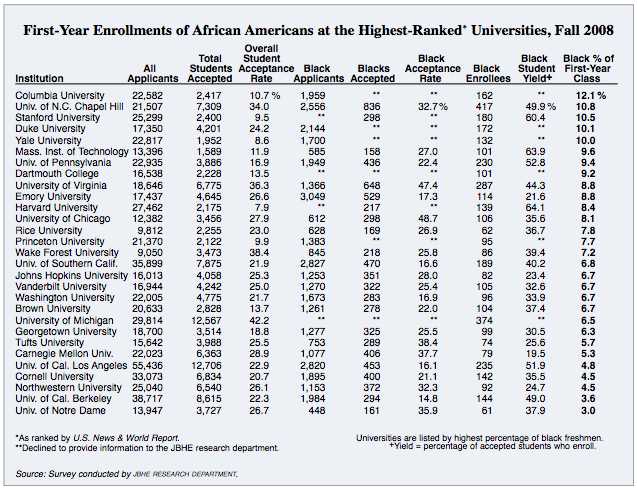
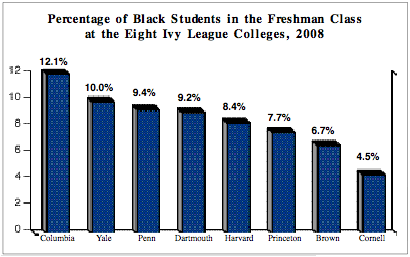 The Massachusetts Institute of Technology ranks sixth in this year’s JBHE survey of black freshmen. This is solid good news in view of the fact that over the years, highly selective institutions with a heavy science curriculum have not been successful in admitting significant numbers of blacks. Despite its heavy emphasis on the sciences, MIT ranks higher in our survey than its crosstown rival in Cambridge, Massachusetts, Harvard University. There are 101 black freshmen at MIT this fall. They make up a remarkable 9.6 percent of the first-year class.
The Massachusetts Institute of Technology ranks sixth in this year’s JBHE survey of black freshmen. This is solid good news in view of the fact that over the years, highly selective institutions with a heavy science curriculum have not been successful in admitting significant numbers of blacks. Despite its heavy emphasis on the sciences, MIT ranks higher in our survey than its crosstown rival in Cambridge, Massachusetts, Harvard University. There are 101 black freshmen at MIT this fall. They make up a remarkable 9.6 percent of the first-year class.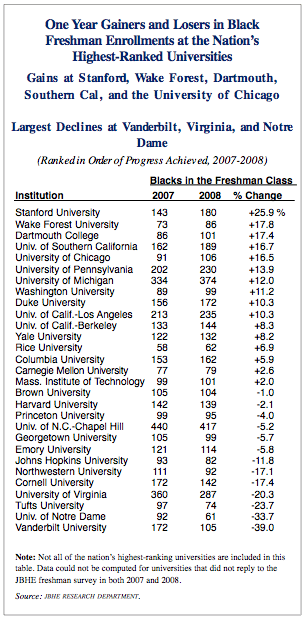 For the 29 high-ranking universities for which we have data for both this year and last, the good news is that 16 universities showed gains over last year in black student first-year enrollments. Thirteen high-ranking universities had declines in their number of entering freshmen who are black.
For the 29 high-ranking universities for which we have data for both this year and last, the good news is that 16 universities showed gains over last year in black student first-year enrollments. Thirteen high-ranking universities had declines in their number of entering freshmen who are black. 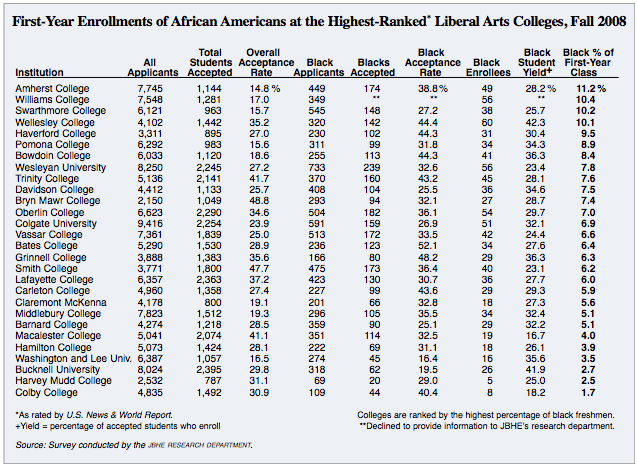
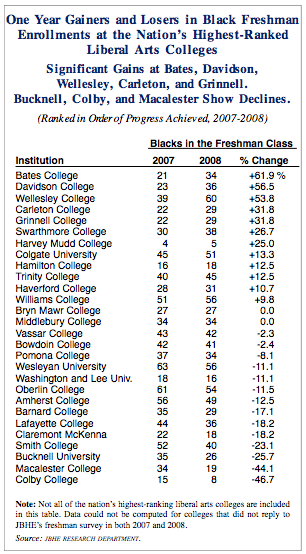 Now we turn to a comparison of this year’s results with the data from last year. For the 28 colleges for which we have data, only 12 colleges have posted gains over last year in black enrollments. In 2007, 17 of the 28 liberal arts colleges reported gains from 2006.
Now we turn to a comparison of this year’s results with the data from last year. For the 28 colleges for which we have data, only 12 colleges have posted gains over last year in black enrollments. In 2007, 17 of the 28 liberal arts colleges reported gains from 2006.